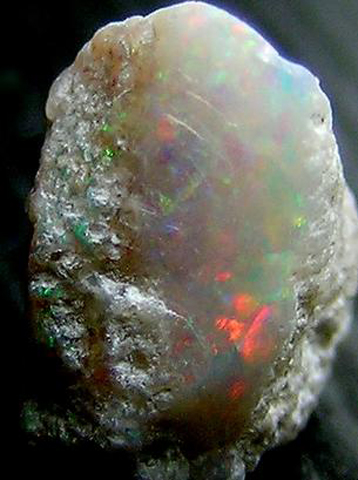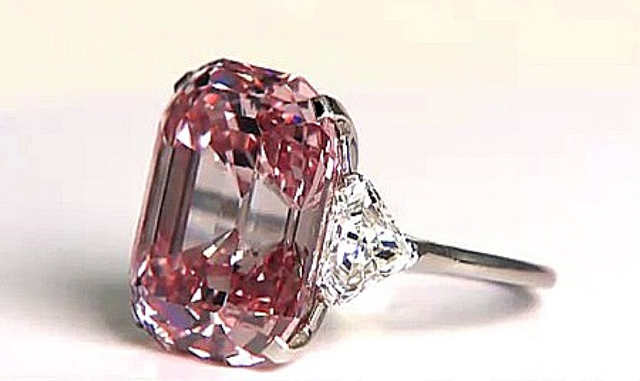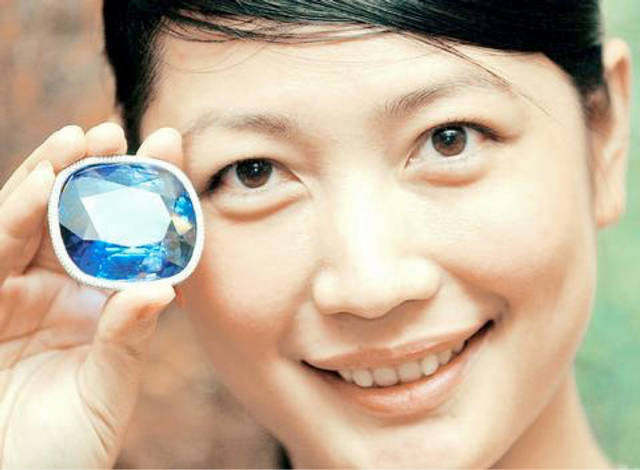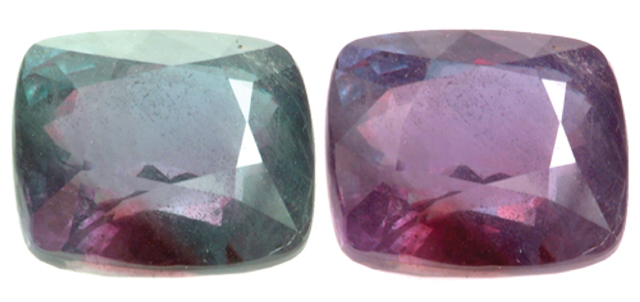| Australian Facetors' Guild Limited |
All types of information can be found here. |
Does Synthetic Spinel Exist? What is it?
Man-made spinel is used extensively. Discovered accidentally when scientists were experimenting to try and produce a flame-fusion blue synthetic sapphire, spinel’s great advantage is that it can be made to reproduce almost all colors except purple. The blue synthetic spinel sapphire imitant is much more genuine looking than a synthetic blue spinels imitating synthetic sapphires.
Although synthetic spinel is also produced by flame-fusion, any resemblance between man-made spinel versus Verneuil rubies and sapphires or other coloured corundums ends at the torch. You'll seldom see bubbles or curved striae in man-made spinel regardless of age.
Some of the imitations using man-made spinel do contain clues, though. An imitation Lapis Lazuli is made by sintering finely ground synthetic spinel and then re compacting it under pressure. Sometimes, real gold is included in the product to simulate the pyrite (fool’s gold) so characteristic of natural Lapis. You can generally spot this imitation because of intensity of the color, and because this color contains an inappropriate reddish influence.
Compare the imitation, too with natural Lapis and you'll see that the luster of the imitation is much too high.
A very authentic looking moonstone imitation is also possible with man-made spinel. Colorless material is reheated long enough for some of the chemical-alumina- to separate out into small corundum crystals. This creates a cloudiness which provides the unique adularescence (the wispy, billowy, light wave) effect to the moonstone.
If the inclusions line up properly a star effect can also be produced. The star effect is often aided by thin metallic coatings on the base of the cabochon. Since it is usually a rather thin cab, there is a noticeable transparency- a good hint that man-made spinel is involved.
The star effect is easily produced in man-made spinel and man-made corundum. A good indication of imitation or synthetic is the sharp rays of the man-mades; they’re just too perfect and straight. Other imitations are achieved by ruled metallic foils underneath and scribing. You can see the coatings (unless it’s hidden by the mounting) or foil backs. Also, a side view while the stone is immersed in water reveals the tell-tale transparency.
Even though man-made spinel is a popular material because of its accommodating nature in manufacture, color, and cut, it still has its shortcomings. Throughout the range of colored gems that it seeks to imitate, a practiced eye can determine that the colors are “off” just a bit from the naturally colored gems. This can be of great help in tipping you off to a man-made spinel.
Strawn-Wagner Diamond

Record: The Only Diamond To Receive A Perfect AGS Grade Of 0/0/0
Crater of Diamonds is a US State Park located in Pike County, Arkansas. In 1990, the most marvellous discovery ever made there, was made when Shirley Strawn found the Strawn-Wagner Diamond. Originally, the diamond weighed 3.09 carats (620 mg) but, after it was cut to a size of 1.09 carats (220 mg), it was given a perfect AGS grade of 0/0/0 by the Gemmological Institute of America, indicating no flaws in cut, colour, and clarity. It was the first time in history that a diamond had received a perfect AGS grade. According to AGS Laboratory Director Peter Yantzer, the diamond is one of the rarest in the world and a one-in-a-billion discovery. It is currently on display at the Crater of Diamonds State Park.
Olympic Australis

Record: The Largest And Most Valuable Opal
In 1956, the largest and most valuable opal in the world was found at the Eight-Mile opal field, in the mining town of Coober Pedy in South Australia. It was discovered at a depth of 9.144 meters (29 feet,) and was named the Olympic Australis opal, due to the Olympic games being held in Melbourne at the time. It weighs a remarkable 17,000 carats (3450 grams,) and is 99% gem quality.
In 2005, the Olympic Australis was valued at AUD $2.5 million. Due to the purity of the jewel, it has been estimated that over 7,000 carats could be cut from the rough stone but, since the rock is so unique, it will be left in its natural organic state. Currently, the Olympic Australis is kept in Melbourne, at the offices of Altmann & Cherny Ltd.
American Golden Topaz

Record: The Largest-Cut Yellow Topaz In The World
The American Golden Topaz currently holds the record for the largest piece of cut yellow topaz in the world. More importantly, it is one of the largest faceted gems of any kind. It is sized at 22,892 carats (4.5785 kg) and has 172-facets (flat-faced cuts applied to gems, in order to help them reflect light.) The gem was cut from a piece of yellow topaz that was 11.8 kg (26 lb) in size. The original mineral was discovered in the Minas Gerais, Brazil, and cut by Leon Agee over a period of two years. In 1988, the American Golden Topaz was donated to the Smithsonian Institute, and put on display in the National Museum of Natural History in Washington, D.C. The price of the gem remains unclear.
7. Graff Pink Diamond

Record: The Most Expensive Gem Ever Sold At Auction
Some of the most valuable gems in the world are coloured diamonds that have been graded (D) and flawless. One such diamond was discovered in the 1950s, when American jeweller Harry Winston purchased a rare pink diamond from an unknown collector. The diamond was 24.78 carats in size, and was described by Winston as “one of the greatest diamonds ever discovered.” It was classified by the Gemological
Institute of America as a “fancy intense pink diamond,” which is an extremely high colour rating. The gem has also been assessed as Diamond Type IIa, placing it in the top 2% of the world’s diamonds. It is cut into a rectangular shape with rounded corners, and is mounted on a ring.
In the 1950s, the diamond was sold by Winston to a private collector, who owned it up until 2010. At that time, it was put up for sale by Sotheby’s auctioneers in Geneva, Switzerland, where the pink diamond sold for US $46 million (£29 million), making it the most expensive single jewel ever sold at auction. It was purchased by diamond dealer Laurence Graff, of Graff Diamonds, who gave it its current name of Graff Pink.
6. Blue Giant of the Orient

Record: The Largest Faceted Blue Sapphire In The World
In 1907, a remarkable huge blue sapphire was discovered near Adams Peak, Sri Lanka. This was a huge deal, as blue is one of the rarest colours of sapphire on the planet. The sapphire was subsequently cut and polished into the Blue Giant of the Orient. At the time, it was reported to weigh 466 carats, and became the largest-faceted blue sapphire in the world.
The Blue Giant of the Orient is a cushion-cut, intense medium-blue colour sapphire that has full colour saturation. The gem displays a strong orange-red fluorescence in ultra-violet light. In 1907, the sapphire was valued at £7,000. It was sold to an anonymous American collector and the whereabouts of the gem were unknown until 2004, when an enormous blue sapphire appeared at Christie’s Magnificent Jewels sale held on May 19th, 2004, at Geneva, Switzerland. The jewel was not advertised as the Blue Giant of the Orient, but the size, cut, and colour were similar, and it is thought to be the same gem. The jewel in the auction was 486.52 carats, and became the largest faceted sapphire of quality ever offered at auction.
Amazingly, the Blue Giant of the Orient did not sell, but was eventually purchased by an anonymous buyer for an incredibly paltry $1 million. The entire sale was suspicious, because of the secrecy and connection to the Blue Giant.
De Beers Diamond

Record: The Largest Missing Diamond In The World
In 1888, the De Beers Diamond was discovered in the Kimberly mines in South Africa. It was one of the largest diamonds ever found, and weighed 428 carats. After the diamond was cut, it became a magnificent 234.65 carat gemstone. The colour of the diamond is pale yellow, and it holds a cushion cut of unknown clarity grade.
The De Beers diamond is currently the eighth-largest faceted diamond in the world. In 1928, the diamond became the centrepiece of the Patiala Necklace, which was created by the House of Cartier for Bhupinder Singh of Patiala. The necklace is one of most valuable pieces of jewellery every created. It contained 2,930 diamonds, including the 234.65 carat De Beers. The total weight of the Patiala Necklace was about 962.25 carats.
In 1948, the necklace disappeared. On May 6, 1982, it was reported that the De Beers diamond was put up for auction at Sotheby’s in Geneva, and fetched a $3.16 million bid, but did not meet the reserve. In 1998, part of the Patiala Necklace was located at a second-hand jewellery shop in London. However, all of the big gemstones were gone, including the De Beers diamond. As of 2013, the De Beers Diamond remains the largest diamond in the world that is not accounted for.
Smithsonian Alexandrite

Record: The World’s Largest-Faceted Alexandrite
The Smithsonian Alexandrite was unearthed in Sri Lanka, and holds a cushion mixed cut. Typical of most alexandrite, the Smithsonian jewel is red and green in colour, and weighs 65.08 carats. It is currently one of the rarest, and most valuable, jewels in the world.
Its status as the world’s largest alexandrite, however, is very much up for debate. In 2011, it was suggested that an alexandrite gemstone named the Naleem Alexandrite weighs over 112 carats, but this can’t be confirmed. It has also been written that a private owner in Japan has a 141.92 carat alexandrite that was certified by the State Gem Corporation. Very little information can be found about the gemstone, but it is listed as the largest cut alexandrite by the Guinness Book of Records website. At 141.92 carats, the alexandrite would be worth over $100 million.
However, until any of these can be confirmed, the Smithsonian remains the verified champion of alexandrite gemstones.
3. Golden Jubilee Diamond

Record: The Largest-Faceted Diamond Ever Cut
In 1985, a worker at the Premier mine of South Africa discovered a large brown diamond the size of 755.5 carats (151 g.) It was one of the largest diamonds ever unearthed, but was initially considered something of an ugly duckling. It even had the nickname of “Unnamed Brown.” The diamond was cut over a period of two years in a specially designed underground room free from vibrations. When completed, it weighed 545.67 carats (109.13 g), which made it the largest cut diamond ever.
After the stone was cut, it turned into a beautiful yellow-brown diamond. In 1994, the diamond was displayed in Thailand and purchased by a group of investors, led by Henry Ho of Thailand. The Golden Jubilee Diamond is currently located in the Royal Thai Palace, as part of its crown jewels. It has been estimated to be worth USD $4-12 million.
2. Neelanjali Ruby

Record: The Largest Double-Star Ruby In The World
Some rubies show a twelve-point asterism, or “star,” on its surface. It is a rare occurrence so, when jewels are found with an asterism, they become much more valuable. The double-star ruby occurs when the asterism is seen from both sides of the jewel, which is even more rare and valuable.
The largest double-star ruby in the world is the Neelanjali Ruby, which weighs 1,370 carats (274 g). It was unveiled to the world at the end of 1988, and immediately entered the Guinness Book of World Records as the largest double-star ruby. The ruby is currently owned by Indian lawyer G. Vidyaraj. When he inherited the ruby, it was covered in layers of grime and soot as, in the past, people thought it was cursed. No one would dare touch the jewel for fear of desecration. The stone remained hidden for centuries until Vidyaraj finally cleaned and polished it, revealing its true beauty. He now claims the gemstone came from the kings of the Vijayanagar Empire, of whom he is a direct descendant.
The exact colour, grade, or clarity of the ruby is not known; nobody even has a picture of the thing (another double-star ruby picture has been used, to give you a basic idea of what such a stone would look like.) Going on the rareness of double-star rubies, its estimated price has been put around $100 million.
1. Bahia Emerald

Record: The Largest Single Shard Of Emerald Ever Discovered
Currently, the largest single shard of emerald ever discovered is the Bahia Emerald, which consists of a huge amount of emerald crystal cylinders, embedded in a host rock that weighs the equivalent of 1.9 million carats. Recently, the Bahia Emerald has received an appraisal as high as $900 million, which would make it the most valuable gemstone in the world. However, most people place the value around $400 million.
It was originally discovered in the beryl mines of western Bahia State, Brazil, on July 9, 2001. After being smuggled to the United States, the Bahia Emerald was eventually moved to New Orleans. After Hurricane Katrina, the Bahia Emerald became submerged under 16 feet of water for two months, before it could be retrieved. The enormous block of emeralds was then stolen by a gem dealer in Las Vegas. After a lead, it was taken into custody by the Los Angeles Sheriff’s Department in a large operation. According to some reports, the Bahia Emerald was involved in a $197 million banking transaction with Bernard Madoff before he was arrested. After a series of legal actions designed to get the emerald back, Judge John A. Kronstadt announced that he would hear the case, though no official ruling has been made yet.
The Bahia Emerald court battle is one of the largest custody lawsuits in California history, and has gained an international following. There are currently eight people who claim ownership to the emerald. One man says he paid $60,000 to a collection of Brazilian miners for the gemstone, while another says he gave up $1.3 million in diamonds for the emerald. If nobody is proven to be the owner, it remains unclear what will happen to the enormous gem.
